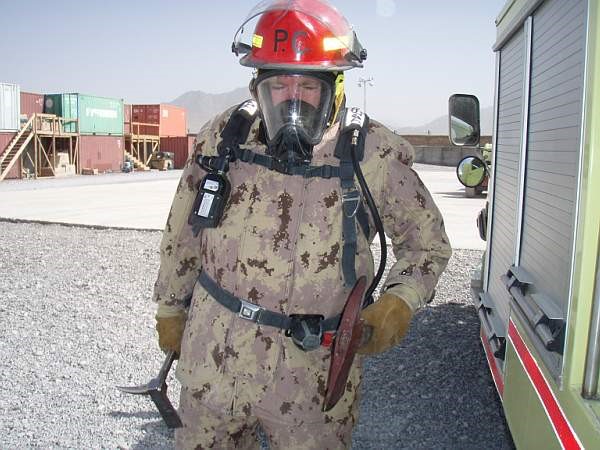Respiratory Protection Program
November 2, 2021 - Defence Stories

Caption
Photo of an aircraft rescue and firefighting (ARFF) firefighter in personal protective equipment including self-contained breathing apparatus (SCBA) supplied air respirator.
The Canadian Forces Fire Marshal Office, as the office of primary interest for the DND/CAF Respiratory Protection Program (RPP), is pleased to share new information and guidance for DND public service employee and CAF member RPP users, their managers and supervisors.
Part II of the Canada Labour Code, the Canada Occupational Health & Safety Regulations (COHSRs), Canadian Standards Association (CSA) Z94.4 Selection, Use and Care of Respirators, CSA Z180.1 Compressed Breathing Air & Systems and CSA Z94.4.1 Performance of Filtering Respirators applies to all personnel, unless operational requirements preclude that for military personnel.
However, there are changes coming to Article 12.13 Respiratory Protection in the COHSRs this fall. Most notably, the new CSA Z94.4.1 will be referenced, offering information on legal procurement alternatives to the existing approved NIOSH Certified Equipment List respirators.
The RPP Canadian Forces Technical Order (CFTO) (accessible only on the National Defence network) C-87-040-000/MS-001 is your DND/CAF guide to the RPP, and includes lists of responsibilities for users and supervisors. The Defence Administrative Order & Directive (DAOD) 5021-21 Respiratory Protection explains the program.
Managers must:
- Secure current Occupational Risk Assessment Reports/Preventive Medicine Technician Walkthrough Inspections, so users know what respirator to wear for what task.
- Managers of civilian users: ensure initial and periodic occupational health assessments from Health Canada to gage fitness to wear a supplied air respirator are conducted. These assessments will also need to be conducted for users who wear air-purifying respirators (APRs) if they identify a risk factor to wearing these safely on the fit-testing Self-evaluation questionnaire.
- Learn when to arrange occupational health assessments, based on occupation and age as provided in Health Canada’s Public Service Occupational Health Program’s 2014 Occupational Health Assessment Guide (OHAG)-Summary of Occupational Health Evaluation requirements by Occupational Group, on GC Connex. You are mandated to do this under the Treasury Board Secretariat Directive on Occupational Health Evaluations.
- Managers of military users: Guidelines for when to arrange occupational health assessments are described in: 4440-01 Chemical Hazards Surveillance Program, 4440-16 Physical Hazards Surveillance Program, 4440-21 Medical Screening of Beryllium Workers, and 4440-20 Reproductive Hazards. There is a new advisory that Director Forces Health Protection – Occupational & Environmental Health expects to release this fall to advise you, entitled Medical Screening.
- Supervisors must:
- Ensure users are fit-tested annually (recommended) but not less than every two years, or more often as needed
- Ensure users pass training before fit-testing
- Ensure training and fit-testing is tracked in Monitor Mass for ALL personnel by Training Coordinators, as the official system of record. Have the Training Coordinator input the details from the user’s fit-test card to record it under the Respiratory Protection Program Domain.